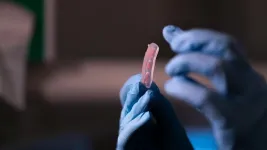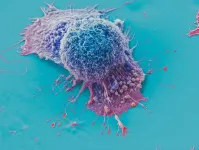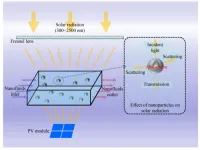(Press-News.org) For engineers working on soft robotics or wearable devices, keeping things light is a constant challenge: heavier materials require more energy to move around, and – in the case of wearables or prostheses – cause discomfort. Elastomers are synthetic polymers that can be manufactured with a range of mechanical properties, from stiff to stretchy, making them a popular material for such applications. But manufacturing elastomers that can be shaped into complex 3D structures that go from rigid to rubbery has been unfeasible until now.
“Elastomers are usually cast so that their composition cannot be changed in all three dimensions over short length scales. To overcome this problem, we developed DNGEs: 3D-printable double network granular elastomers that can vary their mechanical properties to an unprecedented degree,” says Esther Amstad, head of the Soft Materials Laboratory in EPFL’s School of Engineering.
Eva Baur, a PhD student in Amstad’s lab, used DNGEs to print a prototype ‘finger’, complete with rigid ‘bones’ surrounded by flexible ‘flesh’. The finger was printed to deform in a pre-defined way, demonstrating the technology’s potential to manufacture devices that are sufficiently supple to bend and stretch, while remaining firm enough to manipulate objects.
With these advantages, the researchers believe that DNGEs could facilitate the design of soft actuators, sensors, and wearables free of heavy, bulky mechanical joints. The research has been published in the journal Advanced Materials.
Two elastomeric networks; twice as versatile
The key to the DNGEs’ versatility lies in engineering two elastomeric networks. First, elastomer microparticles are produced from oil-in-water emulsion drops. These microparticles are placed in a precursor solution, where they absorb elastomer compounds and swell up. The swollen microparticles are then used to make a 3D printable ink, which is loaded into a bioprinter to create a desired structure. The precursor is polymerized within the 3D-printed structure, creating a second elastomeric network that rigidifies the entire object.
While the composition of the first network determines the structure’s stiffness, the second determines its fracture toughness, meaning that the two networks can be fine-tuned independently to achieve a combination of stiffness, toughness, and fatigue resistance. The use of elastomers over hydrogels – the material used in state-of-the-art approaches – has the added advantage of creating structures that are water-free, making them more stable over time. To top it off, DNGEs can be printed using commercially available 3D printers.
“The beauty of our approach is that anyone with a standard bioprinter can use it,” Amstad emphasizes.
One exciting potential application of DNGEs is in devices for motion-guided rehabilitation, where the ability to support movement in one direction while restricting it in another could be highly useful. Further development of DNGE technology could result in prosthetics, or even motion guides to assist surgeons. Sensing remote movements, for example in robot-assisted crop harvesting or underwater exploration, is another area of application.
Amstad says that the Soft Materials Lab is already working on the next steps toward developing such applications by integrating active elements – such as responsive materials and electrical connections – into DNGE structures.
END
An ink for 3D-printing flexible devices without mechanical joints
EPFL researchers are targeting the next generation of soft actuators and robots with an elastomer-based ink for 3D printing objects with locally changing mechanical properties, eliminating the need for cumbersome mechanical joints.
2024-04-18
ELSE PRESS RELEASES FROM THIS DATE:
Association for Chemoreception Sciences (AChemS) 46th Annual Meeting
2024-04-18
Media Contact:
Dr. Alissa Nolden, Chair - Public Information & Affairs Committee, anolden@umass.edu
Bonita Springs, FL— The Association for Chemoreception Sciences (AChemS) stands as a premier organization dedicated to advancing the understanding of chemosensory systems. With a rich history spanning over four decades, AChemS has played a pivotal role in fostering interdisciplinary research and collaboration in the fields of taste, smell, and chemical senses. AChemS provides a platform for scientists, clinicians, and industry members from diverse backgrounds to exchange ideas, present cutting-edge research findings, and address pressing challenges ...
How the Birmingham Drug Discovery Hub created an investment-ready ‘drug library’
2024-04-18
A novel approach to drug discovery is enabling University of Birmingham researchers to overcome the ‘valley of death’, where projects fail due to the funding gap between original research and commercial investment.
The approach, detailed in a feature published in the April issue of Drug Discovery Today, has attracted more than £4m in industry funding, grants and industry awards, on the back of just £0.2m investment from the University’s Dynamic Investment Fund (DIF).
The Birmingham Drug Discovery Hub ...
Scientists uncover 95 regions of the genome linked to PTSD
2024-04-18
In posttraumatic stress disorder (PTSD), intrusive thoughts, changes in mood, and other symptoms after exposure to trauma can greatly impact a person’s quality of life. About 6 percent of people who experience trauma develop the disorder, but scientists don’t yet understand the neurobiology underlying PTSD.
Now, a new genetic study of more than 1.2 million people has pinpointed 95 loci, or locations in the genome, that are associated with risk of developing PTSD, including 80 that had not been previously identified. The study, from the PTSD working group within the Psychiatric Genomics Consortium (PGC - PTSD) together with Cohen ...
AI tool predicts responses to cancer therapy using information from each cell of the tumor
2024-04-18
With more than 200 types of cancer and every cancer individually unique, ongoing efforts to develop precision oncology treatments remain daunting. Most of the focus has been on developing genetic sequencing assays or analyses to identify mutations in cancer driver genes, then trying to match treatments that may work against those mutations.
But many, if not most, cancer patients do not benefit from these early targeted therapies. In a new study published on April 18, 2024, in the journal Nature Cancer, first author Sanju Sinha, Ph.D., assistant professor in the Cancer Molecular Therapeutics ...
CEOs’ human concern translates into higher stock price
2024-04-18
Compassionate leadership has tangible benefits: CEOs’ expressions of empathy correlate with positive stock performance, a study led by the University of Zurich shows. The researchers analyzed data from conference calls between CEOs and financial analysts during the COVID-19 pandemic.
The COVID-19 pandemic prompted an unprecedented financial crisis. Between 24 February 2020, and 20 March 2020, the value of U.S. companies on the stock market decreased significantly, surpassing the decline during the 2008-2009 financial crisis.
At the onset of the pandemic, several CEOs made statements ...
Smoking-related deaths could be reduced if people attending lung cancer screening are offered stop-smoking support
2024-04-18
A new study has found that by offering stop smoking support as part of the national lung cancer screening programme, there is potential to save lives, and dedicated funding must be considered by policy makers.
The results of the study, published in the European Respiratory Journal, showed that offering stop smoking support at the same time and in the same place as lung screening, resulted in a high uptake of support across a range of demographic characteristics.
This has the potential to reduce smoking-related illness and death in a high-risk ...
Quick decisions in soccer enhanced by brain’s ability to suppress actions
2024-04-18
To pass or not to pass, that is the question faced by soccer players the world over in every match. It might be unsurprising that higher skilled players exhibit better execution of actions than lower skilled ones, but now an Osaka Metropolitan University-led research team has evidence that the neural process to suppress actions also plays an important role.
Research Center for Urban Health and Sports Assistant Professor Takahiro Matsutake and colleagues conducted an experiment to see how three levels of soccer players perform when faced with the same tasks.
The ...
Recycling CFRP waste is a challenge, but we've found a way to make it work
2024-04-18
Carbon fiber reinforced plastics (CFRP) are lighter and stronger than metal and are used in a variety of industries, including aviation, aerospace, automotive, marine, and sporting goods. In recent years, it has also been applied to new industries such as air mobility, which has led to an increase in its use and a waste disposal problem. However, CFRP is not naturally degradable, and high-temperature incineration methods emit toxic substances and cause environmental pollution, so it is urgent to develop ...
Advanced nuclear magnetic resonance technique developed to reveal precise structural and dynamical details in zeolites
2024-04-18
Zeolites are widely used in many industries. There is still a need to fully understand their intrinsic catalytic nature due to the complexity of the hydroxyl-aluminum moieties.
Atomic-scale analysis of local environments for the hydroxyl species is essential for revealing the intrinsic catalytic activity of zeolites and guiding the design of high-performance catalysts. However, many unfavorable factors prohibit the elucidation of their fine structures such as low quantity, meta-stable property, structural similarity, ...
Advancing performance assessment of a spectral beam splitting hybrid PV/T system with water-based SiO2 nanofluid
2024-04-18
As the globe grapples with the urgent need to shift from fossil fuels to sustainable energy sources, solar power stands as a beacon of hope. However, a significant challenge has been to efficiently capture and utilize the full spectrum of sunlight. Traditional photovoltaic (PV) panels convert sunlight into electricity but can't use the entire solar spectrum, especially the infrared part which is often wasted as heat. To address this, photovoltaic/thermal (PV/T) systems have been developed. These hybrid systems ...
LAST 30 PRESS RELEASES:
Why nail-biting, procrastination and other self-sabotaging behaviors are rooted in survival instincts
Regional variations in mechanical properties of porcine leptomeninges
Artificial empathy in therapy and healthcare: advancements in interpersonal interaction technologies
Why some brains switch gears more efficiently than others
UVA’s Jundong Li wins ICDM’S 2025 Tao Li Award for data mining, machine learning
UVA’s low-power, high-performance computer power player Mircea Stan earns National Academy of Inventors fellowship
Not playing by the rules: USU researcher explores filamentous algae dynamics in rivers
Do our body clocks influence our risk of dementia?
Anthropologists offer new evidence of bipedalism in long-debated fossil discovery
Safer receipt paper from wood
Dosage-sensitive genes suggest no whole-genome duplications in ancestral angiosperm
First ancient human herpesvirus genomes document their deep history with humans
Why Some Bacteria Survive Antibiotics and How to Stop Them - New study reveals that bacteria can survive antibiotic treatment through two fundamentally different “shutdown modes”
UCLA study links scar healing to dangerous placenta condition
CHANGE-seq-BE finds off-target changes in the genome from base editors
The Journal of Nuclear Medicine Ahead-of-Print Tip Sheet: January 2, 2026
Delayed or absent first dose of measles, mumps, and rubella vaccination
Trends in US preterm birth rates by household income and race and ethnicity
Study identifies potential biomarker linked to progression and brain inflammation in multiple sclerosis
Many mothers in Norway do not show up for postnatal check-ups
Researchers want to find out why quick clay is so unstable
Superradiant spins show teamwork at the quantum scale
Cleveland Clinic Research links tumor bacteria to immunotherapy resistance in head and neck cancer
First Editorial of 2026: Resisting AI slop
Joint ground- and space-based observations reveal Saturn-mass rogue planet
Inheritable genetic variant offers protection against blood cancer risk and progression
Pigs settled Pacific islands alongside early human voyagers
A Coral reef’s daily pulse reshapes microbes in surrounding waters
EAST Tokamak experiments exceed plasma density limit, offering new approach to fusion ignition
Groundbreaking discovery reveals Africa’s oldest cremation pyre and complex ritual practices
[Press-News.org] An ink for 3D-printing flexible devices without mechanical jointsEPFL researchers are targeting the next generation of soft actuators and robots with an elastomer-based ink for 3D printing objects with locally changing mechanical properties, eliminating the need for cumbersome mechanical joints.







